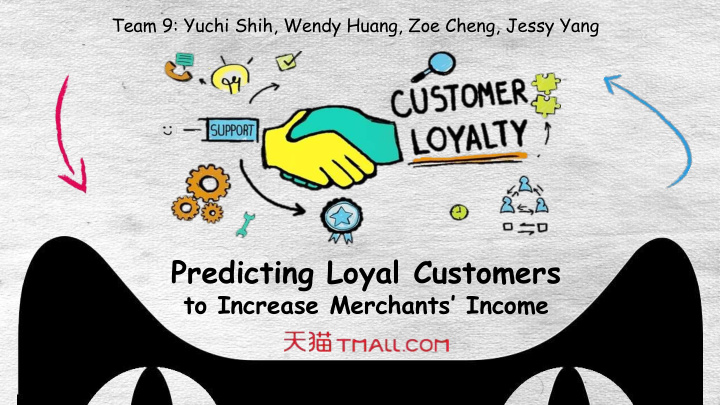



Team 9: Yuchi Shih, Wendy Huang, Zoe Cheng, Jessy Yang Predicting Loyal Customers to Increase Merchants’ Income
Business Goal Stakeholder Sellers on TMall One-time buyers attracted by Problem coupons and discounts (Low ROI) Reduce the promotion cost & Goal increase the rate of the repeated customers
Data Mining Goal Predicting whether this client will be the loyal customer to this seller. Outcome variable: binary outcome(0,1)
• Source: Tmall.com (A huge E-commerce company in China) Data • Data: 1476911 obs. based on actual user activity on the platform • Population: customers who bought on 1111 • Loyal customer: customers bought again in the next 6 month Preprocessing
Data(Data cleaning) 0 Click 1 Add-to-chart 2 Purchase 3 Add-to-favorite
Data • Source: Tmall.com (Top B2C E-commerce platform in China) • Data: 1476911 obs. (those customers all bought on 1111) • Definition of Loyalty: Customers bought again at the same seller in the next 6 month after 1111 • Preprocessing: 1. Missing value : replace missing value by MICE (tree) 2. Derived variable : a. separate action_type variable into action_0, action_1…. b. sum up action_0, action_1…. according to user, seller ID, time_stamp 3. Variable selection : age, gender, action_0~3
Data visualization Click Add to cart Purchase Add to favorite
Visualization (before November)
Methods & Performance Evaluation Data mining methods: Regression, Random forest, XGBoost ● a. K-NN and Hierarchical clustering are not suitable in this case because of the huge dataset. Performance measure: lift chart ● How to map our business goal? ● a. Use the K-means clustering method to cluster the training dataset. b. Build different model for each group by decision tree and regression. c. Predict the outcome and evaluate the performance by confusion matrix. d. The results allow us to predict the potential repeated buyers in each group.
Data Original Undersampling ALL # Records loyal (%) # Records loyal (%) Training 738,455 10.47% 738,455 50% (50%) Validation 443,073 10.46% 443,073 10.46% (30%) Testing 295,383 10.53% 295,383 10.53% (20%)
Result (data=all) Accuracy of top 10% Best Model: Random Forest Benchmark: Naive Rule Naive Rule 10 % Model Logistic Random forest Xgboost Lift Chart Accuracy 23.69% 25.78% 20.43% of top 10%
Result(data=0511-1025) Accuracy of top 10% Best Model Random Forest Benchmark: Naive Rule Naive Rule 10 % Model Logistic Random forest Xgboost Lift Chart Accuracy of 33.96% 48.86% 20.56% top 10%
Result(data=1026-1111) Accuracy of top 10% Best Model Random Forest Benchmark: Naive Rule Naive Rule 10 % Model Logistic Random forest Xgboost Lift Chart Accuracy of 20.4% 24.61% 18.32% top 10%
Recommendations For Implementation For Model Risk For Business Policy 1. Models might require 1. Low accuracy of top 10% 1. Collect more data about updates 2. The total error rate would characteristics of the 2. When encountering be higher if undersampling. sellers. missing value, we have to 3. The dataset exists some 2. Increase the customer’s understand what missing value such age willingness to add their happened so that we can and gender. product into favorite. properly deal with it. 4. Since the samples 3. Lurkers are potentially increase enormously and loyal customers, which rapidly in the last two the sellers should not weeks, the bias might ignore these people. affect the outcome.
Implementation/Production Considerations Time difference: This dataset was collected from 2 years ago. A certain period of data: The dataset only contains half year of the business data. Therefore the ● model might require updates as time goes, in case features changes. For instance, if there is a new brand not included in this dataset, it might ● not be able to predict the results. Lack of information: Not included merchants’ or discounts’ data.
Recommend
More recommend